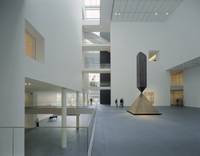Friday, November 19, 2004
The Modern Museum vs. the Museum of Modernism
Ezra Pound distilled the bubbling, restless drives of his generation with his command to “make it new.” So strong was this decree, so firmly was it taken to heart, that the whole of the last century belonged to the avant-garde.
No organization has done more to institutionalize the twentieth-century avant-garde than the Museum of Modern Art. With the debut of its new home this week, MoMA has announced how it, as an institution, plans to move itself out of the twentieth century and into the twenty-first.
 Visitors will notice immediately that with this building MoMA has made the decision to play to its greatest strength: its collection. Members of the board put egos aside to raise $850M for this expansion, of which $725M is already in hand. With their money, they have bought a marvelous machine, a marvelously designed machine, for viewing modern art.
Visitors will notice immediately that with this building MoMA has made the decision to play to its greatest strength: its collection. Members of the board put egos aside to raise $850M for this expansion, of which $725M is already in hand. With their money, they have bought a marvelous machine, a marvelously designed machine, for viewing modern art.
Architect Yoshio Taniguchi has said that he wanted to “create a total environment for people and art, not a style of architecture.” The light, the views, the galleries, the public spaces, the restaurants available on the premises—everything works to create an environment where outside distractions are removed, visitors are made comfortable, and attention is focused on the art.
 The museum has become, in effect, Alfred Barr’s white cube writ large. The building’s design philosophy acknowledges the city while removing its distractions. It provides a luxurious (but not intrusively opulent) environment where art can be experienced with clarity and focus.
The museum has become, in effect, Alfred Barr’s white cube writ large. The building’s design philosophy acknowledges the city while removing its distractions. It provides a luxurious (but not intrusively opulent) environment where art can be experienced with clarity and focus.
That’s what the board wanted, and that’s what it has received. Evaluating the success of the project against its objectives leads to a judgment that simply can’t be argued: the new MoMA is an exceptional accomplishment.
Wags, however, have begun referring to the institution this week as the “Metropolitan Museum of Modern Art.” The epithet carries more than a kernel of truth.
 With the new building MoMA has taken a giant step towards making modernism academic. All the drive, the edge, the rawness, and the grit that have been characteristic of twentieth century art have been washed away with this exceptionally clean, well lit, and sleek space.
With the new building MoMA has taken a giant step towards making modernism academic. All the drive, the edge, the rawness, and the grit that have been characteristic of twentieth century art have been washed away with this exceptionally clean, well lit, and sleek space.
Gordon Matta-Clark’s handiwork with a chainsaw, for example, has been made silent, clean, and sterile by its presentation in the new contemporary art galleries. Viewers of this piece will not think about the violence, noise, and destruction that occurred to create the artifact on exhibit in this most impressive of spaces. Instead, they will marvel that the gallery is large enough to hold pieces of a whole other building.
One wonders how the new MoMA would differ if its funders and designers had made a different strategic decision early on in the project. What would MoMA be like if they had tried not to display comfortably the work of a century of avant-garde artists but if they had instead tried to create a new museum-going experience or a new way of interacting with and exploring art for our new century—if they had, essentially, taken Pound’s modernist dictate to heart and had decided to “make the museum new”?
MoMA chose not to embrace new thinking about the museum’s function with this expansion; rather, it chose to build a monument to twentieth-century modernism. It’s a wonderful monument, and anyone would be hard pressed to argue that it’s not. But it’s just that: a monument. Monuments are made for memorializing events of the past. Not for celebrating activities of the present. And not for enabling innovation in the future.
No organization has done more to institutionalize the twentieth-century avant-garde than the Museum of Modern Art. With the debut of its new home this week, MoMA has announced how it, as an institution, plans to move itself out of the twentieth century and into the twenty-first.
 Visitors will notice immediately that with this building MoMA has made the decision to play to its greatest strength: its collection. Members of the board put egos aside to raise $850M for this expansion, of which $725M is already in hand. With their money, they have bought a marvelous machine, a marvelously designed machine, for viewing modern art.
Visitors will notice immediately that with this building MoMA has made the decision to play to its greatest strength: its collection. Members of the board put egos aside to raise $850M for this expansion, of which $725M is already in hand. With their money, they have bought a marvelous machine, a marvelously designed machine, for viewing modern art.
Architect Yoshio Taniguchi has said that he wanted to “create a total environment for people and art, not a style of architecture.” The light, the views, the galleries, the public spaces, the restaurants available on the premises—everything works to create an environment where outside distractions are removed, visitors are made comfortable, and attention is focused on the art.
 The museum has become, in effect, Alfred Barr’s white cube writ large. The building’s design philosophy acknowledges the city while removing its distractions. It provides a luxurious (but not intrusively opulent) environment where art can be experienced with clarity and focus.
The museum has become, in effect, Alfred Barr’s white cube writ large. The building’s design philosophy acknowledges the city while removing its distractions. It provides a luxurious (but not intrusively opulent) environment where art can be experienced with clarity and focus.
That’s what the board wanted, and that’s what it has received. Evaluating the success of the project against its objectives leads to a judgment that simply can’t be argued: the new MoMA is an exceptional accomplishment.
Wags, however, have begun referring to the institution this week as the “Metropolitan Museum of Modern Art.” The epithet carries more than a kernel of truth.
 With the new building MoMA has taken a giant step towards making modernism academic. All the drive, the edge, the rawness, and the grit that have been characteristic of twentieth century art have been washed away with this exceptionally clean, well lit, and sleek space.
With the new building MoMA has taken a giant step towards making modernism academic. All the drive, the edge, the rawness, and the grit that have been characteristic of twentieth century art have been washed away with this exceptionally clean, well lit, and sleek space.
Gordon Matta-Clark’s handiwork with a chainsaw, for example, has been made silent, clean, and sterile by its presentation in the new contemporary art galleries. Viewers of this piece will not think about the violence, noise, and destruction that occurred to create the artifact on exhibit in this most impressive of spaces. Instead, they will marvel that the gallery is large enough to hold pieces of a whole other building.
One wonders how the new MoMA would differ if its funders and designers had made a different strategic decision early on in the project. What would MoMA be like if they had tried not to display comfortably the work of a century of avant-garde artists but if they had instead tried to create a new museum-going experience or a new way of interacting with and exploring art for our new century—if they had, essentially, taken Pound’s modernist dictate to heart and had decided to “make the museum new”?
MoMA chose not to embrace new thinking about the museum’s function with this expansion; rather, it chose to build a monument to twentieth-century modernism. It’s a wonderful monument, and anyone would be hard pressed to argue that it’s not. But it’s just that: a monument. Monuments are made for memorializing events of the past. Not for celebrating activities of the present. And not for enabling innovation in the future.